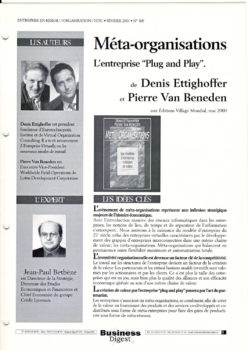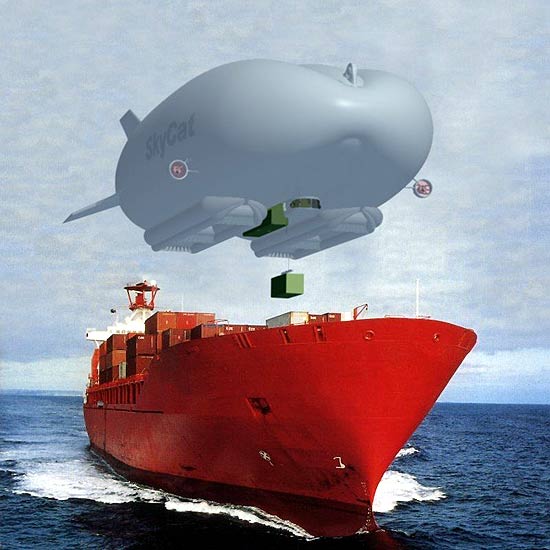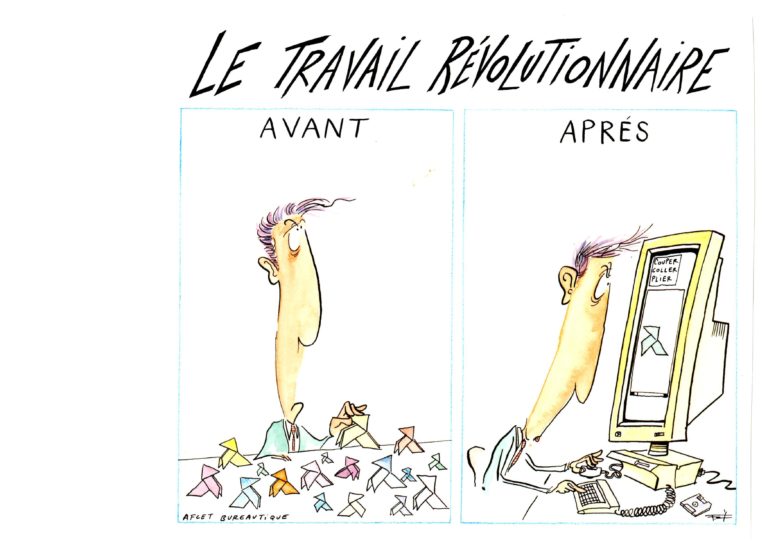
The Key is Organizational Innovation
IDEAS
In the future the challenge will not be having the largest number of computers and technologies. It’s the quality of organizations that will make the big difference. Denis Ettighoffer
More than simple technological power – now accessible to the entire planet – the quality of organizations, their overall effectiveness, has become the key to the future for companies and nations alike. However, this effectiveness can only be achieved by networking companies and fueling the innovation of these communties’ organizational approaches. Here the author returns to one of the themes of his book « Met@-Organizations, Models for Value-Creating Enterprises. »
DENIS ETTIGHOFFER is the founding president of the Eurotechnopolis Institut and of Virtual Organisation Consulting. Among other books, he is the author of The Virtual Enterprise (2001) and co-author, with Pierre Van Benedem, Met@-Organizations, Models for Value-Creating Enterprises, which won the Turgot prize for best economic book of the year 2001. The changes presently occurring within companies, and within our society, originated in the widespread diffusion of information and communication technologies (NICT). There is a long cycle of change in progress that is radically transforming the structure of value creation. The growth of new industries or services, built upon the network of networks, is off to a good start. The distribution of goods and services is undergoing a number of changes. The ratio between work intensity and capital intensity, which plays a role in determining the prices of goods and services, is being challenged. The mechanisms of knowledge diffusion and product life cycles have changed, and the organizational models of companies and institutions are being deeply challenged. Finally, the creation of new jobs creates a skills deficit in activity sectors and markets that were unknown only a decade ago. In short, this economic and organizational reorganization won’t spare many.
The companies of this new millennium are eager to learn the ropes of the network enterprise and the network economy. Here, companies find a low-cost way to globalize, to mingle with a multitude of economic players, including clients, with whom they now have a direct relationship. For all of us, this is the most effective and energy-consuming way to work, trade, and invent new products and services. Yet, despite their IT investments, the majority of these firms will not survive if they remain in an « organizational deficit » when faced with the fundamental changes generated by the neteconomy.
 Technology is not a gage of competitiveness With the diffusion of information and communication technologies, technological power has become a major economic motor. It has also become an instrument of the competition among nations, though far from guaranteeing success. In 1997, realizing they were far behind their American counterparts, Japanese companies launched a campaign they called « one employee, one computer ». When the magazine Nikkei Zero (the equivalent of 01 informatique in France) asked if the initiative had been a success, the answer came that it had been a total failure (reported by Courrier International dated 3/19/97). And yet, with 8 million personal computers sold in 1995 and 10 million in 1996, the Japanese were buying four times more technical equipment than the French. The Americans, with 850 dollars per inhabitant, were investing eight times more than the world average (Les Échos, 1/10 and 10/9/97).
Technology is not a gage of competitiveness With the diffusion of information and communication technologies, technological power has become a major economic motor. It has also become an instrument of the competition among nations, though far from guaranteeing success. In 1997, realizing they were far behind their American counterparts, Japanese companies launched a campaign they called « one employee, one computer ». When the magazine Nikkei Zero (the equivalent of 01 informatique in France) asked if the initiative had been a success, the answer came that it had been a total failure (reported by Courrier International dated 3/19/97). And yet, with 8 million personal computers sold in 1995 and 10 million in 1996, the Japanese were buying four times more technical equipment than the French. The Americans, with 850 dollars per inhabitant, were investing eight times more than the world average (Les Échos, 1/10 and 10/9/97).
At the end of the Eighties, as the diffusion of NICTs continued steadily, the growth of investment slowed in all countries, and even dropped in countries like France and the United States. This is when Nobel Prize winner Solow hit the bullseye with his paradox: « I see computers everywhere except in [productivity] statistics! » One study shows that in the United States, in full swing with its IT investments, the increase in productivity in the manufacturing sector slowed between 1995 and 1999. In France, a study conducted by the Pierre Audouin Conseil firm, and the INSEE data collected by Le Monde Informatique, confirmed that increases in work productivity are not directly proportionate to technology expenditure. Furthermore, a study of the economic climate conducted by the French ministry of economics and finances notes that, despite the continuous development of technological investments, productivity gains experience a durable slowdown.
Studying IT investments, it quickly becomes obvious that the relationship between the growth of computing power and the GDP or unemployment remains insignificant. But these figures are misleading. In reality, overall productivity grew significantly. The GDP continued to grow, but wealth creation was no longer directly proportionate to the quantity of work, nor to the quantity of investment, but rather to organizational innovation.
The amount of IT investment alone does not make it possible to judge its pertinence. Michaël Skok, distributor of groupware products, remarked, « Over the last decade, American companies spent 800 billion dollars on information technology and purchased 60 million personal computers. During this time administrative productivity grew less than 1% yearly (01 Informatique, 10/15/93). Business Week proposes that companies spent 1000 billion dollars over a period of ten years, affirming that productivity gains remain insignificant, that these investments kill jobs, and that information technology hardly proves profitable. A dangerous cocktail, but one that seems to feed on the weakness of the organizational restructuring project. Attempting to boost a company with IT investments serves only as a stopgap if there is no innovative, visible and legitimate organization project for the actors in question. Without some imagination to conceive of new forms of organization the company will only tread water. To make a real difference you must explore new ways to do things. Shuffling through studies on the yo-yo effect of IT investments, it quickly becomes obvious that the direct relationship between the growth of computing power and the GDP, or unemployment, remains insignificant.
For lack of any clearly defined alternatives, company executives played the technology card to gain competitiveness. By doing this they made the opposite mistake of those who believed that the growing quantity of computers was directly proportionate to the growth of unemployment: there is no direct relationship between the number of computers a company possesses and its capacity to create wealth.
The key is interconnectiveness – This relationship should be sought in the number of interconnections among computers and then in the in the capacity of corporate or social cultures to exchange ideas and knowledge, and in a company’s capacity to build partnerships. This is where communication networks come into play. In other words, the economic development of a company, or country, depends on its capacity to favor the creation of combined added value (which better utilizes its intangible investments) and overall productivity gains (which optimizes trade flows among interdependent organizations) thanks to the networking of the economic actors.
This is precisely the key to the extraordinary vitality of the growth in the US. This vitality is due – and this is the second factor capable of answering Solow’s paradox – to the networking of companies. The World Wide Web has become one big global « Plug and Play » network (You plug it in and you play) for companies that organize and combine into business networks. Nevertheless, for lack of visibility in their organizational plans, the NICTs did result in productivity gains, but these were limited to compartmentalized, Taylorian settings. An executive at a large bank summed it up in his own way when he remarked, « the billions injected into networks of computers still haven’t allowed his team to improve communication among all the different departments. » The need for « knowledge-intensive » employees increased companies’ administrative and salary costs, which quickly ate up the slender gains achieved. On the balance sheet, payroll expenses and information technology budget grew proportionately (1).
Once again, it was becoming obvious – sometimes too late – that technological contributions were limited by the weakness of organizational contributions. » We know how to manage organizations. We know how to manage technology. We do not know how to manage the interaction between the two », remarked Bruno Latour (2), analyzing the compartmentalization of the disciplines of science, technology and corporate management in an interview with Les Echos in October 1992. Technological intensity alone is not enough to make a difference. Japan’s technological intensity is much superior to other regions of the triad, but that doesn’t make it any easier for it to preserve its economic leadership. Similarly, in France the weight of investments in certain sectors like banking has not been synonymous with productivity gains or strategic advantages over others.
The concept of the combination of technological power and the control of mass markets is still a major theme in industrial strategies – The concept of the combination of technological power and the control of mass markets is still a major theme in industrial strategies. That hasn’t stopped Japan – and other nations – from continuing their downward spiral because they weren’t capable of renewing the organization of their conglomerations, by questioning their approach to hierarchy and work flexibility. The slender results observed in terms of productivity, competitive differentiation and innovation, notably in online services, were a result of the deficit of organizational innovation, combined with a resistance to technologies on behalf of society in general.
Innovation slowed by fear of technology – A latent « technological crisis » exists in the West. The sociologist Alain Touraine remarked, « we no long believe that science and technology progress leads to social and human progress (L’Express, special 40th anniversary issue). « Technology works against employment, » adds Jean-Jacques Salomon in an article published in L’Expansion (in June 1993). « Should we torch computers? » asks an article in Challenges (January 1993), in which the author wonders if the eight hundred billion French francs invested in information technology over the last twelve years in France haven’t helped, especially to reduce unemployment. And to charm its established customer base, in 1997 the American company Sun launched an extensive advertising campaign with the themes « rejection of technopollution » and « technological overdose. » In short, the « society and the technology empire are divorcing due to irreconcilable differences, » according to Roger Lesgards (3).
All these negative mindsets, not necessarily inexact but sometimes biased and very hyped, are the consequence of an orthodoxy that limits, or curbs, innovation. It limits the majority of initiatives proposed by executives, entrepreneurs or managers of public administrations. The divorce between the general public and technological progress is so profound, and the debate so crucial, that in 1999, at a global conference on science in Budapest, UNESCO proposed « to draw up a new contract between science and society. »
The example of computers perfectly symbolizes the duality of our attitudes towards the advances in science and technology. On one hand, the growing popularity of computers proves that people are becoming familiar with computers, which are thus losing their mysterious aspect. On the other hand, their image will be more closely associated with the threat of unemployment. People distrust technology even more because the opportunities it offers have often been the source of reductions in payroll expenditures, as an increasing number of people have been laid off. For executive management NICTs remain, above all, a way to yield returns through work productivity gains, rather than a way to create extra added value.
I should add here that with all these reflections on the means of cooperation, on global challenges and on high performance systems, employees systematically feel deceived by all this obscure intellectual talk, even though they are the key to a company’s success. Overall gains in productivity are not due only to technology investments but to a series of organizational solutions based on the capacity of humans to work together. Generally, our social patterns have been the number one reason behind the failure to introduce NICTs into our organizations.
Cultural patterns condition understanding – Our cultural patterns condition our understanding of technology and the ways we use it. For example, our relationship to time and space has been turned completely upside down over these last few decades by the advent of computer networks. Today we can hardly imagine the problems workers in the Fifties faced when phoning or traveling. Our western society of impatience would find it pretty hard to readapt to past ways of living and working.
Technological objects still contribute to the development and transformation of non-technological fields. For example, the mushrooming of technology in the United States and Europe doesn’t fit into one homogeneous model. In 1998 Chinese-American and migrant families owned the majority (53%) of computers connected to the Internet, because the web allowed them to communicate with family members all over the world. The average fell to 11% for American households overall. In short, interpreting this phenomenon requires a minimum of caution and is conditional upon understanding the geographic economics of each country’s culture. What is true at the society level is true at the corporate level as well. Thus, computer-assisted collaborative work applications (groupware) are more successful in northern Europe than in the South.
With all these reflections on the means of cooperation, on global challenges and on high performance systems, employees systematically feel deceived by all this obscure intellectual talk, even though they are the key to a company’s success.
I should emphasize that when an innovation is merely the product of a technology breakdown, or an answer to a new need, its origin is secondary. But when it has a significant organizational impact, the contrary is true. Furthermore, if this innovation is connected to processes of interdependence among foreign organizations, the risk of maximum resistance is much more important. Whatever the supposed economic advantages for the organization are, the social tribe feels threatened.
If we admit that information and communication technologies are resources of organizational innovation, then they belong to a cultural heritage whose appropriation will be conditional upon a process of technological familiarization. This will involve building this heritage within companies, and trying not to confine it to the sole janglings of technocrats. When, in the early Nineties Vinton G. Cerf, co-founder of the Internet and chairman of the ‘Internet Society’, had to prepare a presentation about the Internet for a convention, he sent a message over the Usenet asking users what the network meant to them and how it could be more useful. In just a few hours he received dozens of answers. Each gave a vision of an improved organization in terms of business, communications, and personal or professional exchanges. It wasn’t up to the technicians to say what the network should do, but up to the users to indicate what it did for them, what they got out of it.
In keeping their technological objects from users, instead of allowing them to explore their different applications, technologists have played a role in limiting organizational inventiveness. To make matters worse, applications have remained in an economic field that had to justify the increase in tied up capital (NICTs) through the speculative reduction of mobilized personal capital (jobs). An absurd situation that the managers of the Scribe project, of the French Ministry of Finance, had to handle when it moved to Bercy in the mid-Eighties. In exchange for the billions of French francs invested in information technology, they had to gain a comparative amount in payroll expenditures. One can only imagine the impact of this discussion on the employees and labor unions. Since nobody had any real leeway to revise the organization, the whole thing went no further than a prudent exchange of gobbledygook. In the end, over a period of four years, 6 billion francs were invested in the computer automation project.
When a technological innovation incorporates a change in organizational model, the organizational impact can be major and the economic advantages for the company obvious. But instead of an advantage there can be social prejudice. No matter how good the technological innovation and its potential applications are, the social resistance of entire occupational sectors can considerably limit its diffusion or even block it entirely. Yet with the neteconomy, the majority of the problems that today’s managers face result from the introduction of technologies designed to solve complex organizational problems. Technology dissemination can only work when investments in training are significantly increased. This investment will be proportional to the age of the employees and the estimated impact this change will have on the organization’s traditions. This consumes a lot of money and « employee time », which must be reduced if you don’t want to see your company disappear (unless you get around the problem by creating an altogether different organization).
NICTs, the misunderstood technologies
The heirs of Fayol – a French consultant who, after World War II, founded one of the first industrial organization consultancy firms based on American methods, and on the rationalization of support services – will have to come up with new business and organizational models. The strong interest shown in the early Nineties in the French and international press for the concept of the virtual corporation demonstrates the great importance attached to organizational innovation.
This misunderstanding of the role of NICTs in the radical reform of corporate economic and organizational models was one of the causes of the relative failure of reengineering. Companies have engaged in such complicated reorganizations that the NICTs are the cause of significant ruptures. Most companies can’t stand the idea of questioning themselves. The failures of the first two attempts to install an Intranet in one of the largest global communication companies in the world were the result of the company’s inability to accept all-out communication. The Intranet was reserved for members of the international staff – who incidentally weren’t at all inclined to use it. But to explicitly suggest this as the reason for failure is downright insulting to the executives of this company.
We are witnessing the integration of knowledge into all of the intelligent fields, including new products and services. Why shouldn’t organizations be a part of this? IT applications are incorporating a growing number of organizational innovations resulting from the pluridisciplinary experience of other occupational sectors. Modeling a myriad of different functions blurs the distinction between tool and organization. Companies now purchase competitive advantages rather than technologies.
The misunderstanding of the role of NICTs in the radical reform of corporate economic and organizational models was one of the causes of the relative failure of reengineering. In reality, in the mid-Nineties reengineering, like mergers and restructuring programs, were but the meager epi-phenomena of the great race for organizational innovation made possible by the virtualization of corporations. The real show was elsewhere, in the new inventiveness sprouting out of companies that formed alliances and merged together to form meta organizations. The company of the 21st century is emerging from this extraordinary proliferation of original and imaginative organizations, tossing out all the traditional parameters for measuring productivity and value creation.
Lack of imagination threatens performance – Europe’s competitiveness is threatened, not because it lacks the means but because it lacks imagination in the use of information and communication technologies. Guillaume Franck (4) sums up the problem in one phrase: « Americans thought our executives were sophisticated and intellectually superior as individuals. But theirs actually contrast the sophistication and superior efficiency of their companies » (L’Expansion, 11/5/97). In response, Arie de Geus (5), who maintained that only 30% of Fortune 500 companies survive through fifteen years of changes in their sectors and markets, showed that those who survive are in a continuous cycle of learning and adapting. All executives should memorize this quote from Albert Einstein: « I’m interested in the future because that’s where I’m going to spend the rest of my life. »
The process of destroying/creating jobs jumped on the progress bandwagon and the cycle sped up. The design/marketing phases went nuts. Our companies were operating on a « marketing minute » plan and, searching for high-performance solutions, went hyperproductive and virtualized. Production went global; twenty-one countries were participating in the production of a Peugeot cycle. It was the musical chairs game from hell. All it took was one link in the chain that knew how to produce or put a together a product less expensively in another country, and the whole factory would change nationality.
The company of the dawn of the 21st century is nothing like today’s. New chains of added value are forming as the barriers of traditional organizations are broken down.
Regardless of the labor cost drivers, the future economic nightmare lurked behind the fact that organizations had not fully adapted to the virtualization of the economy, and in the low expectations of sectors that continued to automate to excess, to a point where they could almost operate without humans. All of this accelerated the job creation/destruction process. In the summer of 1993, the Bureau of Labor Statistics announced that the chances of an employee finding another job were 4 to 1. These were the most alarmist statistics on the job market since 1982. Only internal re-training, or a very progressive organization renewal plan, allowed companies to absorb the shock and avoid an outburst of social unrest.
Faced with the changes in work methods and wealth creation, we have every right to fear the incapacity of certain nations to create conditions favorable to the renovation and fertilization of new types of competitive companies. I might as well say it here: the nations that encourage and support an administrative economy, and a proletariat wage-earning class rather than the development of the corporate spirit, will suffer more than they can imagine. By becoming instruments of wealth creation, upon going virtual companies will make an increasingly economical use of the « workforce ». America already has a force of some 32 million self-employed workers. With the neteconomy, the creation of activities and new professions exceeds job creation.
Organization, a growth motor For a long time, the supremacy of technology over organization limited the amount of inventiveness needed for companies to adapt. Having a good product or service is no longer enough; companies must also have an organization adapted to the new economic models made possible by electronic networks. It’s quickly becoming obvious that this inventiveness will have growing consequences on their economic performance. The company of the dawn of the 21st century is nothing like today’s. New chains of added value are forming as the barriers of traditional organizations are broken down. One of the reasons for the brazen prosperity of certain companies can be found in their extraordinary capacity to produce organizational innovation. Today the real factor in competitive differentiation is built-in organizational intelligence. To such an extent that the stock market regularly flares up to pay tribute to the most outstanding innovations.
Organization and economic performance are closely related in the neteconomy. The neteconomy also transforms the post-industrial society into an economic and social laboratory. The best-informed communities and the most imaginative individuals will profit from NICTs by fundamentally transforming themselves. A process of renewing the economic fabric, owed to the increasing virtualization of the economy and its activities, is fundamentally challenging the organization models designed in the mid-20th century. Now the productivity of IT investments, just like the resulting differentiation among companies, will depend on the relative inventiveness of network organizational models.
(1) Denis Ettighoffer, The Virtual ’Enterprise and New Ways of Working, Odile Jacob, 1992.
(2) Bruno Latour, researcher at the center for innovation sociology, professor at the Ecole des Mines and at the University of California San Diego, author of Aramis ou l’amour des techniques (Editons de la Découverte, October 1992).
(3) Roger Lesgards (ex-president of the Cité des Sciences et des Techniques), Preface, L’empire des Techniques, Point Sciences .
(4) Guillaume Frank, professor at HEC (Hautes Etudes Commerciales) in Paris, author of A la conquête du marché Américain (Odile Jacob, 1997)
(5) « La Pérennité des entreprises », Maxima-Institut du Management EDF, 1997. Arie de Geus, professor at the London School of Economics.














